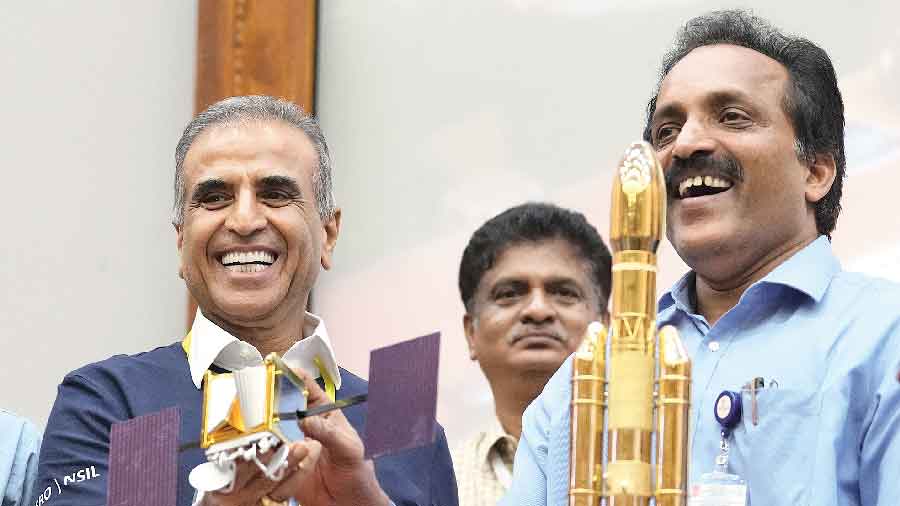India’s largest rocket early on Sunday safely ferried into low-Earth orbit 36 satellites for a UK communications company, shining through its first commercial mission with its heaviest payload yet.
The Launch Vehicle Mark-3 (LVM3) blasted off from the Sriharikota island spaceport with a six-tonne payload at 12.07am and released the satellites in nine separate batches of four about 610km above the Earth, the mission lasting 75 minutes.
The successful mission will bolster space market confidence in the LVM3 that has become the Indian Space Research Organisation’s second commercial rocket after the Polar Satellite Launch Vehicle (PSLV) that has launched foreign satellites for over 23 years, Isro officials said.
The 36 satellites are part of a planned constellation of 648 satellites owned by OneWeb, a UK company that seeks to provide broadband services across the world starting 2023. India’s telecom company Bharti Airtel owns 30 per cent of OneWeb through a $1 billion investment.
This was the fifth launch of the LVM3, earlier called the Geosynchronous Satellite Launch Vehicle Mark-3, after four successful missions carrying various Isro satellites, including the Chandrayaan-2 lunar spacecraft in July 2019.
Isro chairman Sreedhara Somanath described the Sunday launch as a “historic mission” that will pave the way for future launches with the LVM3, a rocket that has now demonstrated its capacity to launch six-tonne payloads into low-Earth orbit.
“The injection of the satellites was so precise to the expectation of the customer,” Somanath said. The LVM3 — Isro’s largest and most powerful rocket — was primarily conceived to launch four-tonne payloads into geosynchronous orbits about 36,000km above the Earth.
OneWeb currently has 428 satellites in orbit, launched between February 2017 and February 2022, all by Russia’s Soyuz rockets from spaceports in French Guyana or Russia. The Sunday launch has raised the count to 462, or 70 per cent of the satellites needed for global coverage.

Isro chairman S Somanath (right) with Bharti Enterprises chairman Sunil Bharti Mittal during a news conference after the successful launch of the rocket PTI Picture
Isro has bagged a second contract to launch another set of 36 OneWeb satellites in early 2023, the deals facilitated by the Russia-Ukraine war that has stalled Russian launches of OneWeb satellites.
“The geopolitical situation favoured India, there was an opportunity…. We were quick to respond and grabbed the opportunity,” Somanath told a social media channel earlier this month, saying the success lay in offering a rocket with the required interface and capabilities to meet OneWeb’s requirements.
The National Space India Limited (NSIL), the commercial arm of Isro, executed the contract with OneWeb in a record time of three to four months, space officials said.
“Today’s launch is a significant milestone for OneWeb,” said Sunil Bharti Mittal, executive chairman of OneWeb, who was among those present at the launch in Sriharikota. “My dream of having an Indian element in the OneWeb constellation has been realised,” he said in a statement released by OneWeb.
Isro plans to use the LVM3 to launch the Chandrayaan-3 lunar spacecraft in June 2023 and send astronauts into space after several launches of unmanned space capsules over the next two years.
On Sunday, all stages of the LVM3, including the critical cryogenic engine powered by liquid oxygen and liquid hydrogen, performed as intended during the rocket’s 15 minutes of powered flight starting with the rocket rising into the midnight sky, spewing white-orange flames.
The cryogenic engine shut down as planned 15 minutes into the flight when the vehicle had reached an altitude of about 605km and was over the southern Indian Ocean. But the cryogenic stage had to orient and re-orient itself several times to inject the satellites safely without collisions.
The satellites began separating from the vehicle in batches of four, starting about 19 minutes into the flight. After the release of four batches, the vehicle moved over the other side of the planet — beyond the visibility of tracking stations in India — where it released five more batches.
Isro had until February 2022 launched 129 Indian satellites and 342 foreign satellites from 36 countries. The PSLV began launching foreign satellites in 1999.










